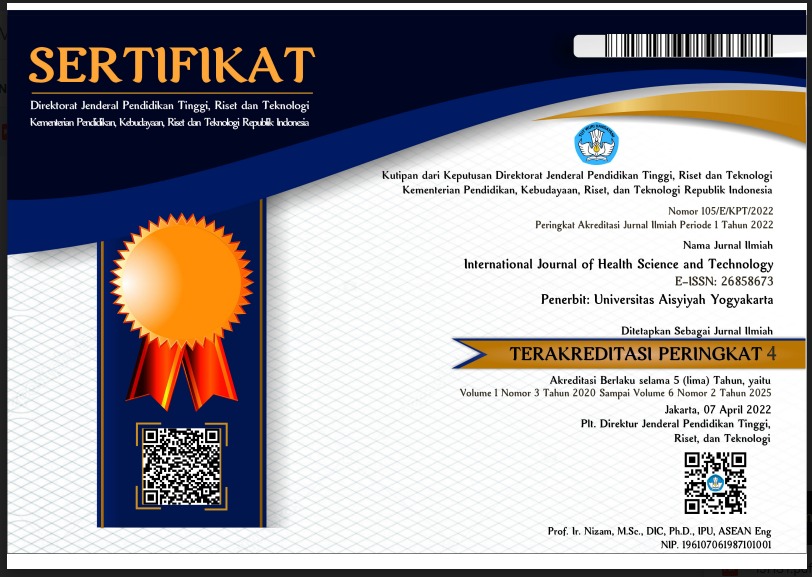Effect of high consumption the phyto-protein on quality of wound healingperineal on the postpartum at Primary Health Center Mlati II District Sleman
DOI:
https://doi.org/10.31101/ijhst.v1i3.1275Abstract views 1301 times
Keywords:
phyto-protein, wound healing perinealAbstract
References
BKKBN, (2011). Profil Hasil Pendataan Keluarga Tahun 2011. Badan Kependudukan dan Keluarga Berencana Nasional Direktorat Pelaporan dan Statistik. Jakarta.
Craig, W.J., & Mangels, A.R. (2009). Position of the American Dietetic Association: Vegetarian Diets. Journal of the American Dietetic Association. 109(7). 1266–1282. https://doi.org/10.1016/j.jada.2009.05.027
Hayu, R., Rohmawati, L. A., & Alie, Y. (n.d.). (2013). Perineum Di Wilayah Kerja Puskesmas Cukir Kabupaten Jombang (Correlation Between Nutrition Status and Healing of Ulcer Perineum At Public Health of Cukir Jombang), 17–22.
Ija, M. 2009. Pengaruh Status Gizi Pasien Bedah Mayor Pre Operasi Terhadap Penyembuhan Luka dan Lama Rawat Inap Pasca Operasi di RSUP. Dr. Sarjito Yogyakarta. Tesis S2. Yogyakarta. Pascasarjana UGM.
Kementerian Kesehatan RI. (2016). Profil Kesehatan Indonesia 2015. https://doi.org/351.077 Ind
Lebang, Erikar. (2015). Food Combining Itu Gampang: Tubuh Sehat Ideal Walau Makan Kenyang. Bandung: Mizan Media Utama.
Nurhikmah. (2009). Hubungan Perilaku Ibu Berpantang Makanan Selama Nifas Dengan Status Gizi Ibu Dan Bayinya Di Kecamatan Banjarmasin Utara Di Kota Banjarmasin. Jurnal Tesis Universitas Gajah Mada.
Peles, Z., & Zilberman, M. (2012). Novel soy protein wound dressings with controlled antibiotic release: Mechanical and physical properties, Acta Biomaterialia. 8(1). 209–217. https://doi.org/10.1016/j.actbio.2011.08.022
Sugiyono. (2014). Metode Penelitian Kuantitatif, Kualitatif dan R&D. Bandung.
Alfabeta. Supiati, & Yulaikah, S. (2015). Pengaruh Konsumsi Telur Rebus Terhadap PercepatanPenyembuhan Luka Perineum Dan Peningkatan Kadar Hemoglobin Pada Ibu Nifas. Jurnal Terpadu Ilmu Kesehatan Poltekkes Surakarta. 4(2). 82–196.
Utari, D. M., Hadi, R., & Muhilal, R. (2011). Potensi Asam Amino pada Tempe untuk Memperbaiki Profil Lipid dan Diabetes Mellitus Potency of Amino Acid in Tempeh for Improving Lipid Profile and Diabetes, Kesmas. 5(4). 166–70.
WHO. (2012). World Health Statistics. WHO World Health Organization (Vol. 27). https://doi.org/10.2307/3348165
Downloads
Published
How to Cite
Issue
Section
License
International Journal of Health Science and Technology allows readers to read, download, copy, distribute, print, search, or link to its articles' full texts and allows readers to use them for any other lawful purpose. The journal allows the author(s) to hold the copyright without restrictions. Finally, the journal allows the author(s) to retain publishing rights without restrictions
- Authors are allowed to archive their submitted article in an open access repository
- Authors are allowed to archive the final published article in an open access repository with an acknowledgment of its initial publication in this journal

This work is licensed under a Creative Commons Attribution-ShareAlike 4.0 Generic License.










